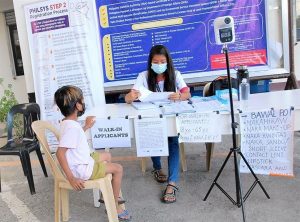National ID registrations approaching 89 million
AROUND 89.7 million registrations have been logged for the Philippine Identification System (PhilSys) card, or the National ID, the Philippine Statistics Authority (PSA) said on Monday. The signups constitute 97% of the government’s 90-million target for the year, Assistant National Statistician Emily R. Pagador told reporters on the sidelines of a forum. By next year, […]

AROUND 89.7 million registrations have been logged for the Philippine Identification System (PhilSys) card, or the National ID, the Philippine Statistics Authority (PSA) said on Monday.
The signups constitute 97% of the government’s 90-million target for the year, Assistant National Statistician Emily R. Pagador told reporters on the sidelines of a forum.
By next year, the PSA aims to have the entire population registered, Ms. Pagador said.
While the PSA has yet to deliver 35 million physical National ID cards, those registered under PhilSys may use the digital version of the IDs in government and bank transactions.
The PSA is also working with other banks to accept the National ID for authentication. It recently began the pilot use of National ID authentication services with the Land Bank of the Philippines East Avenue branch.
“We have issued an advisory about the acceptance of the digital National ID. It has the same validity as the physical ones,” Ms. Pagador said.
Last month, the Bangko Sentral ng Pilipinas (BSP) issued a memorandum requiring all BSP-Supervised Financial Institutions to accept all forms of the National ID, including the digital version.
Entities that have integrated the National ID into their operations include Asia United Bank, GCash, GoTyme, Bank of the Philippine Islands, Home Credit Philippines, the Government Service Insurance System, the Home Development Mutual Fund or Pag-IBIG, and the Philippine Health Insurance Corp.
Ms. Pagador added that complaints regarding organizations not accepting the National ID have fallen to the single digits. They topped 100 in 2021.
The National ID has helped lower the cost and time for residents seeking to obtain a business permit by 75%, World Bank Senior Digital Development Specialist Naoto Kanehira told the forum.
Meanwhile, Republic Act No. 11055 or the Philippine Identification System Act still requires the delivery of the physical National ID cards.
“We are working on something to continue the printing of the (physical) cards,” Ms. Pagador said.
The central bank terminated its printing contract with AllCard, Inc., and the dispute has gone to arbitration. The BSP is overseeing the printing of physical ID cards.
The National ID is expected to help boost growth in the next decade by helping the vulnerable and the unbanked access key government and financial services, Information and Communications Technology Secretary Ivan John E. Uy told the forum.
“The National ID will be instrumental in driving the nation’s economic growth. It is projected to contribute significantly, up to 10%, in GDP (gross domestic product) over the next 10 to 15 years,” he said.
The PSA has partnered with the University of the Philippines and the Modular Open Source Identity Platform to launch a research and design center to realize the potential benefits of the National ID. — Beatriz Marie D. Cruz












